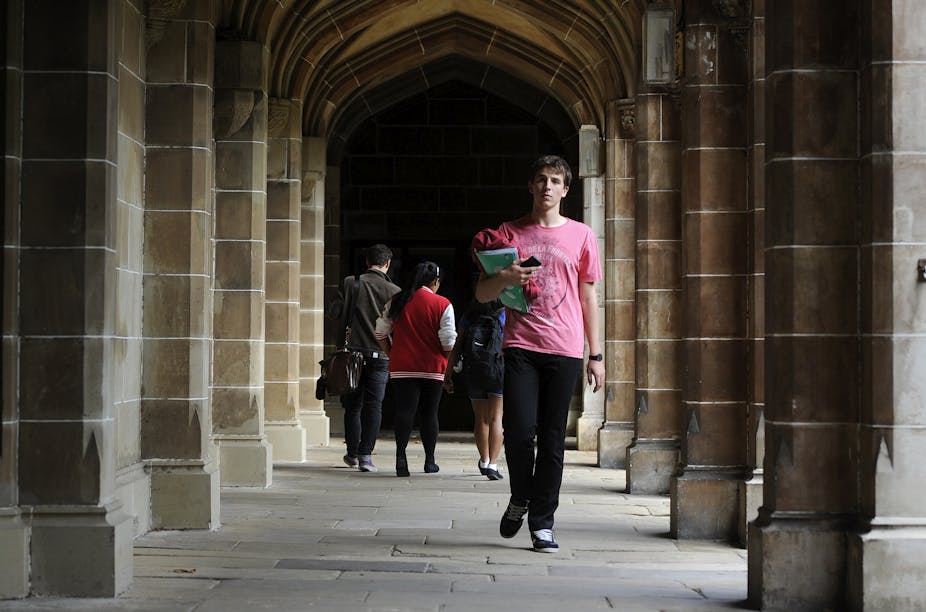With notable exceptions, higher education leaders seem ready to accept the latest funding cuts. But the Group of Eight’s Michael Gallagher has gone further, strongly endorsing the reforms as “logical, coherent, sustainable, equitable and inevitable”. Detractors, he said, are on “the wrong side of history”
…supporting socially regressive subsidies from general taxpayers to more advantaged segments of the community.
Education minister Christopher Pyne has returned the favour by strongly endorsing this view. He quotes these Gallagher lines to support the 20% cut to student subsidies as “fairer to taxpayers”. As Pyne once said, taxpayers deserve flowers, chocolates and gratitude from students because:
60% of Australians who don’t have a university degree are paying for 60% of the degrees of those who will go on to earn up to $1 million more
Then we have the treasurer’s recent speech at the Sydney Institute. There Joe Hockey reprised Pyne’s “60% who pay 60%” line and said:
Fairness is the key to our higher education reforms. No longer will the brickie, the painter, and the chef be subsidising the degrees of the dentist, the doctor or the lawyer to the extent that they currently are
Whatever we make of the “vibe” here, the Pyne-Hockey script is a pungent blend of old and new arguments.
Is public funding “socially regressive”?
The old argument goes back to when Labor introduced fees via HECS loans in the 1980s. This broke with its “tuition-free” policy brought in by Gough Whitlam in the 1970s. As Gallagher tells it, Whitlam’s approach was “regressive” because it:
… freed those who could afford to pay from doing so and transferred the bulk of the cost burden to taxpayers who gained no private benefit from the spending.
As the 1980s ended, this was how Labor justified fees. In Parliament recently, Pyne responded to critics by quoting a 1995 speech from Paul Keating:
… a “free” higher education system is one paid for by the taxes of all, the majority of whom haven’t had the privilege of a university education. Ask yourself if you think that is a fair thing.
Can students pay more?
The new argument is that with HELP loans, higher graduate incomes justify lower subsidies. This draws on the Grattan Institute’s Graduate Winners report, which compared graduate earnings with those of year 12 school leavers. Finding big income disparities, its authors asked at what point higher fees would outweigh the dollar benefits of a degree.
In most fields, they argued, graduates are “such big winners” that people would study even without subsidies. They proposed cuts of up to 50% in the short term, and longer term to zero.
The government’s 20% cut is a step down this path. If subsidies are so “regressive”, why not go all the way?
Who pays for “graduate winners”?
This “students versus taxpayers” script gets three things right. Today, taxpayers cover 60% of average course costs. And while estimates vary, most graduates will earn far more than most school leavers. And yes, about 60% of working age adults don’t have university degrees.
But the punchline is that these people pay too much for today’s students. This doesn’t match the facts. As Hockey said in the same speech:
… just 10% of the population pays nearly two thirds of all income tax.
Let’s see. For 2011-12, ATO figures show that 64% of all net income tax was paid by the top 17% of taxpayers. At the low end 46% of taxpayers paid less than 4% of net tax.

Meanwhile ABS estimates show that in 2011-2012 the average Australian household received more in government benefits, in cash or in kind, than it paid in income taxes.
So, who exactly are the unqualified 60% who subsidise student careers? The 46% on lower incomes? No. Average households? No. That leaves higher income earners, many from the 38% of working-age Australians who are already tertiary-qualified.
Mixing fact and fiction
That the 60/60 line is a script error becomes clear in Hockey’s speech. His message that tax revenue is over-reliant on high-income earners contradicts his message about who is subsidising students. And the 60/60 line won’t work for law students anyway: they already meet over 80% of the cost of their degrees.
The treasurer needs more economic advisors, and fewer creative accountants.
Gallagher’s line, meanwhile, is a Dawkins-era tag now past its use-by date. To call Whitlam’s subsidies “regressive” is a fair call for the 1970s, when not many people needed degrees in a very different economy. The tag may also apply to the 1990s when Keating gave the speech from which Pyne quotes. But Keating defended a policy that made students meet 23% of their course costs. Not today’s 40%, and not the 50% now on offer.
The Pyne-Hockey “student versus taxpayers” script is a social justice fairy tale. The subsidy cuts aren’t designed to fix an equity problem, but a budget problem that could be fixed in other ways. Their net effect is that well-off taxpayers, many of them graduates, can short-change students by saddling them with larger HELP debts.
Ask yourself if you think that is a fair thing.

